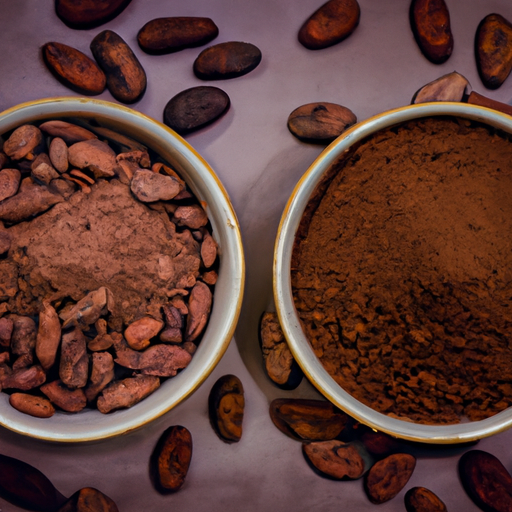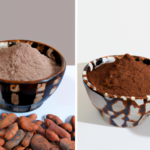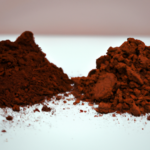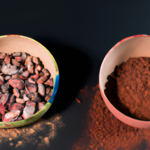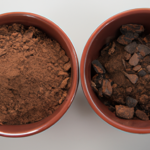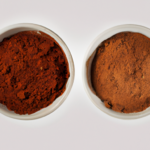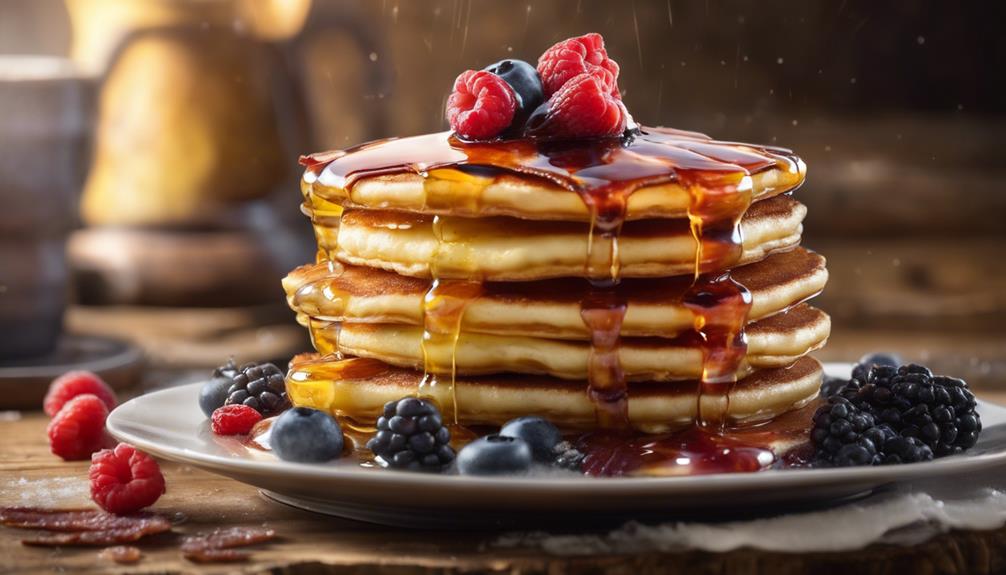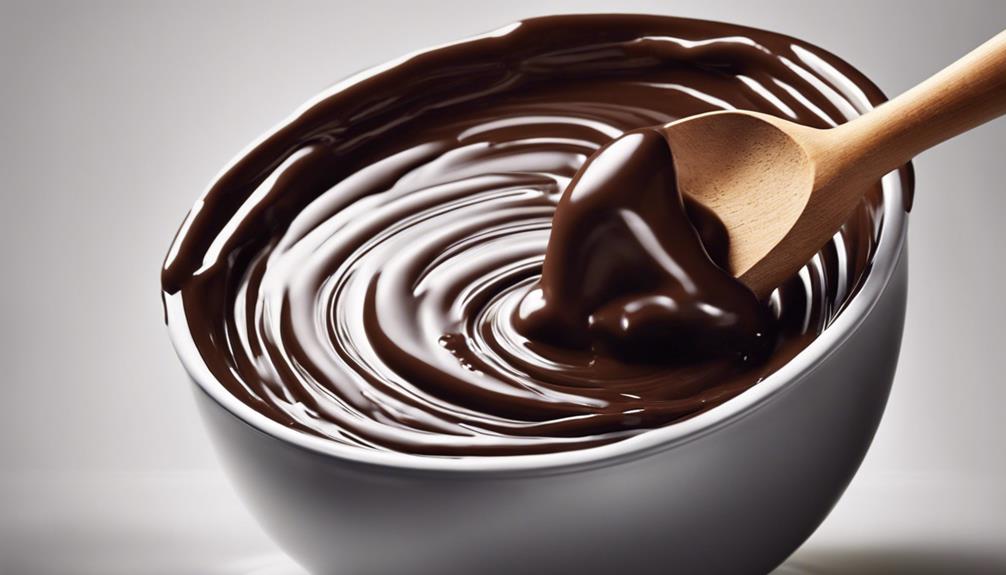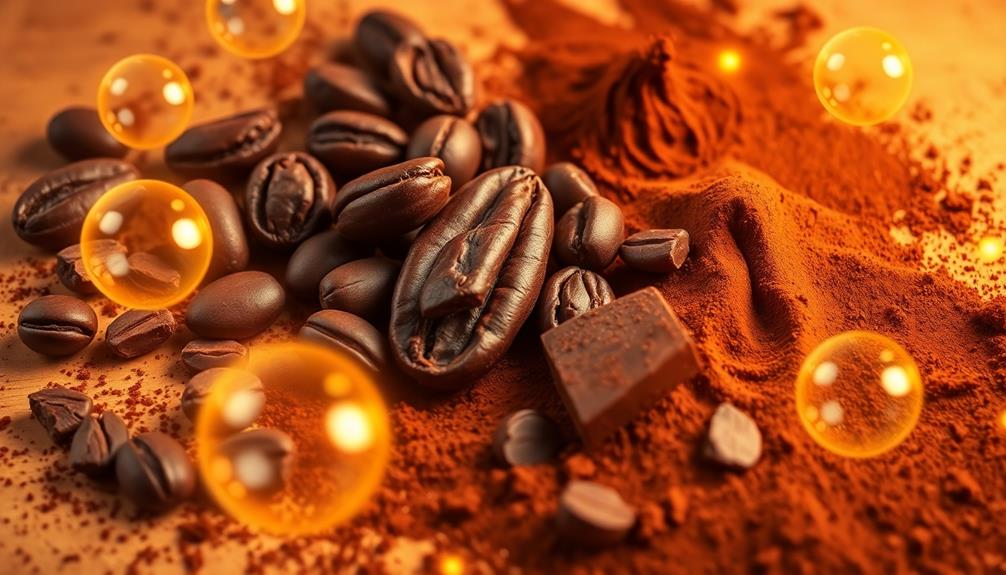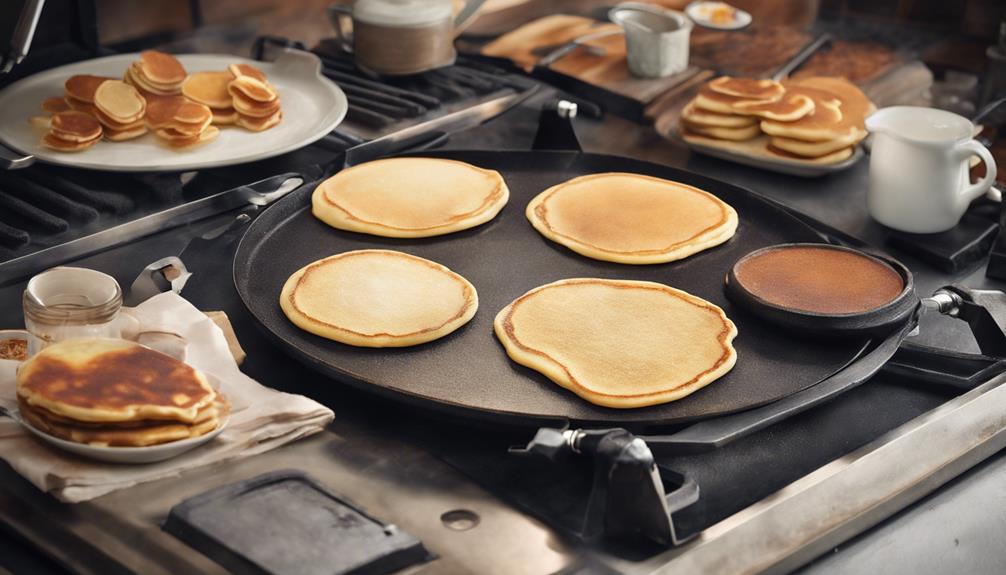Have you ever pondered the contrast between raw cacao and cocoa? Allow me to illuminate you. While raw cacao and cocoa may seem alike, they possess unique qualities that differentiate them. In this article, we will delve into the origins, nutritional variances, flavor profiles, processing techniques, culinary applications, health advantages, availability, cost, and sustainability of these two common ingredients. By the conclusion, you will have a clearer grasp of which choice is best suited for you.
Now, imagine this: you’re standing in the baking aisle of your local grocery store, staring at the shelves filled with various cocoa and cacao products. It can be overwhelming, right? That’s why it’s important to know the key differences between these two ingredients.
So, let’s dive in and explore the fascinating world of raw cacao and cocoa!
Key Takeaways
- Raw cacao and cocoa are both accessible and affordable, with cocoa being slightly more budget-friendly.
- Raw cacao requires less processing than cocoa, leading to differences in availability and pricing.
- Raw cacao is often sourced from small-scale farmers who prioritize fair trade and sustainable practices, while cocoa may come from large-scale plantations that may not prioritize ethical practices.
- Raw cacao retains more nutrients compared to cocoa.
The Origins of Cacao and Cocoa
Cacao and cocoa, both derived from the vibrant pods of the tropical cacao tree, have been cherished and cultivated by indigenous cultures for centuries. Cacao farming has a rich historical significance, with evidence of its cultivation dating back to ancient civilizations in Mesoamerica. The Mayans and Aztecs revered cacao as a sacred plant, using it in religious rituals and as a form of currency.
The historical significance of cacao farming cannot be overstated. It played a central role in the social, economic, and cultural fabric of these ancient societies. The cultivation of cacao required immense knowledge and skill, as it thrived in specific climatic conditions and required careful attention to harvest and processing techniques.
Moving forward into the subsequent section about nutritional differences, it is important to understand the roots of cacao and cocoa to fully appreciate their unique qualities.
Nutritional Differences
There are notable contrasts in the nutritional content between these two chocolate ingredients.
Raw cacao is known for its exceptional nutritional value, as it is minimally processed and retains more of its natural compounds. It is rich in antioxidants, minerals like magnesium and iron, and contains healthy fats.
On the other hand, cocoa undergoes a more extensive processing technique, which reduces its nutritional value. It is still a good source of antioxidants and minerals, but it may contain added sugars and other ingredients that can affect its overall health benefits.
When comparing raw cacao and cocoa, here are five key differences to consider:
- Raw cacao is higher in antioxidants than cocoa.
- Raw cacao has more magnesium and iron than cocoa.
- Raw cacao contains healthy fats, while cocoa may have added fats.
- Raw cacao is less processed than cocoa.
- Raw cacao has a more intense and bitter flavor compared to cocoa.
Now, let’s delve into the next section about the flavor profiles of raw cacao and cocoa.
Flavor Profiles
Get ready to indulge in the delightful world of flavors as you explore the distinct taste profiles of these two chocolate ingredients.
Raw cacao has a rich and intense flavor that is often described as bitter or earthy. It has a deep and complex taste that can vary depending on the specific variety of cacao used.
On the other hand, cocoa has a milder and sweeter flavor compared to raw cacao. It is often associated with a more familiar chocolate taste that we are used to. The flavor of cocoa can be described as slightly fruity or floral.
Understanding the differences in flavor between cacao and cocoa can help you choose the right ingredient for your recipes.
Now, let’s move on to the next section about processing methods.
Processing Methods
Now let’s dive into the fascinating world of how chocolate is made and explore the various methods used to process these delectable ingredients. When it comes to raw cacao vs cocoa, the processing methods play a significant role in determining their flavor and health benefits. Here are a few processing methods that evoke excitement and anticipation:
-
Fermentation: This crucial step enhances the flavor and reduces bitterness, resulting in a smoother and more complex taste.
-
Roasting: The heat transforms the raw cacao or cocoa beans, developing rich aromas and intensifying the flavors.
-
Grinding: This process breaks down the beans into a thick paste, known as chocolate liquor, which is the foundation of all chocolate products.
-
Conching: This technique involves continuously stirring the chocolate to refine its texture and smoothness, creating a velvety mouthfeel.
Understanding these processing methods helps us appreciate the remarkable journey from bean to bar.
Speaking of culinary uses, let’s explore the versatile ways chocolate can be incorporated into our favorite dishes.
Culinary Uses
When it comes to culinary uses, raw cacao is perfect for raw desserts and smoothies. Its rich, intense flavor adds depth to these creations while maintaining the nutritional benefits of the raw cacao bean.
On the other hand, cocoa is a versatile ingredient that can be used in various baked goods and hot beverages. Its processed form makes it easier to incorporate into recipes and provides a familiar chocolate taste.
Whether you’re looking for a healthy twist or a classic chocolate flavor, raw cacao and cocoa offer different options for your culinary creations.
Raw Cacao: Ideal for Raw Desserts and Smoothies
Indulge in the rich and velvety flavor of raw cacao, perfect for elevating your raw desserts and smoothies to a whole new level.
Raw cacao, with its intense chocolate taste, is a versatile ingredient that can be used in a variety of raw cacao recipes. Not only does it add a decadent flavor, but it also boasts numerous health benefits.
Raw cacao is packed with antioxidants, which help protect your body against free radicals. It is also a great source of magnesium, iron, and fiber. Incorporating raw cacao into your desserts and smoothies not only satisfies your sweet tooth but also provides a nutritional boost.
Now, let’s transition to the subsequent section about cocoa: a versatile ingredient for baking and hot beverages.
Cocoa: Versatile Ingredient for Baking and Hot Beverages
Cocoa, with its rich and warm aroma, adds a depth of flavor to baked goods and hot beverages that is reminiscent of a cozy fireplace on a winter’s night. It is a versatile ingredient that can be used in various baking techniques to create delicious treats.
Here are four popular recipes that showcase the versatility of cocoa:
- Classic chocolate chip cookies
- Decadent chocolate cake
- Creamy hot chocolate
- Fudgy brownies
These recipes demonstrate how cocoa can be used to create a range of desserts that are loved by many. Its intense flavor and natural acidity help to balance the sweetness in baked goods, while its rich color adds visual appeal.
Furthermore, cocoa powder can be easily incorporated into hot beverages, providing a comforting and indulgent experience.
As we move into the next section about health benefits, it’s important to note that cocoa can be enjoyed not only for its taste but also for its potential health benefits.
Health Benefits
Discover the amazing health benefits of raw cacao and cocoa, and how they can boost your well-being!
Raw cacao and cocoa have both earned their superfood status due to their numerous health benefits. One of the key advantages of consuming these ingredients is their positive impact on cognitive function. Studies have shown that the flavanols found in raw cacao and cocoa can enhance brain health by improving blood flow to the brain and increasing cognitive performance.
Additionally, these ingredients are rich in antioxidants, which help protect the body against harmful free radicals and reduce inflammation. Incorporating raw cacao or cocoa into your diet can also support heart health, improve mood, and provide essential minerals like magnesium and iron.
Now, let’s delve into their availability and price, so you can make an informed decision about which option suits you best.
Availability and Price
When it comes to availability and price, you’ll be pleased to know that both options are widely accessible and affordable, with cocoa being slightly more budget-friendly than raw cacao. Here are a few factors to consider regarding availability and pricing:
-
Global Demand: The demand for both raw cacao and cocoa has been steadily increasing, leading to a rise in production and availability worldwide.
-
Location: Depending on where you live, the availability of raw cacao and cocoa may vary. However, with the growth of e-commerce, it’s easier than ever to find both options online.
-
Processing Methods: Raw cacao generally requires less processing than cocoa, which can influence its availability and pricing.
Considering the availability challenges and pricing factors, it’s important to note that sustainability and ethical considerations also play a significant role in choosing between raw cacao and cocoa.
Sustainability and Ethical Considerations
One important factor to consider in choosing between raw cacao and cocoa is the sustainability and ethical impact.
Ethical sourcing is a key consideration when it comes to these products. Raw cacao is often sourced from small-scale farmers who prioritize fair trade and sustainable practices. This means that they receive fair wages for their work and use environmentally friendly farming methods.
On the other hand, cocoa can sometimes be sourced from large-scale plantations that may not prioritize ethical practices.
In terms of environmental impact, raw cacao production tends to have a lower carbon footprint compared to cocoa production. This is because raw cacao is minimally processed, resulting in less energy consumption and waste.
Considering these factors, it is clear that raw cacao is a more sustainable and ethical option.
Transitioning into the subsequent section about ‘Conclusion: Choosing the Right Option for You’, it is important to weigh all these factors to make an informed decision.
Conclusion: Choosing the Right Option for You
After considering the sustainability and ethical aspects of raw cacao and cocoa, it’s time to make a decision that aligns with our values and preferences. So, which option is the right one for you?
Let’s weigh the factors. When it comes to health benefits, both raw cacao and cocoa offer antioxidant properties and potential mood-boosting effects. However, raw cacao is less processed and retains more nutrients.
On the other hand, availability and price play a significant role in our decision-making process. While raw cacao may be harder to find and more expensive due to its niche market, cocoa is widely available and more affordable.
Ultimately, choosing between raw cacao and cocoa depends on personal priorities and circumstances. Consider these factors as you make your decision, and remember to enjoy the rich flavors and benefits that both options can offer.
Frequently Asked Questions
Can raw cacao and cocoa be used interchangeably in recipes?
Yes, raw cacao and cocoa can be used interchangeably in recipes. Raw cacao and cocoa both offer numerous benefits in recipes, such as adding rich flavor and providing antioxidants, making them great choices for any recipe.
Are there any potential side effects or risks associated with consuming raw cacao or cocoa?
There are potential health risks associated with consuming raw cacao or cocoa, including effects on cardiovascular health. It is important to be aware of these risks and consume them in moderation.
What is the recommended daily intake of raw cacao or cocoa for maximum health benefits?
The recommended daily intake of raw cacao or cocoa for maximum health benefits varies, but studies suggest consuming 1-2 tablespoons of cocoa powder or 1-2 ounces of dark chocolate with high cacao content.
Are there any specific storage requirements for raw cacao or cocoa to maintain their freshness and quality?
To maintain the freshness and quality of raw cacao or cocoa, it is important to store them properly. According to research, keeping them in a cool, dark, and airtight container can help extend their shelf life and preserve their flavor and nutritional benefits.
Can raw cacao or cocoa be used in beverages other than hot chocolate?
Raw cacao and cocoa can be used in various beverages beyond hot chocolate. They offer different beverage options and provide numerous health benefits when incorporated into drinks.
What are the Health Benefits of Raw Cacao vs Cocoa?
Raw cocoa vs cacao differences are minimal, but raw cacao is less processed and retains more nutrients. It’s packed with antioxidants, iron, and magnesium, which are beneficial for heart health, mood regulation, and energy levels. Cocoa, on the other hand, may have added sugars and fewer nutrients due to processing.
Conclusion
In conclusion, after exploring the differences between raw cacao and cocoa, it’s clear that both have their unique qualities.
While raw cacao provides a more intense and pure chocolate flavor, cocoa offers a milder taste.
One potential objection might be the higher price of raw cacao. However, imagine indulging in a velvety smooth raw cacao dessert, savoring every rich and decadent bite. The satisfaction and health benefits it brings make it worth the investment.
So, next time you’re faced with the choice, consider treating yourself to the delightful world of raw cacao. Your taste buds will thank you.

